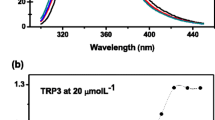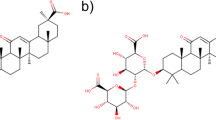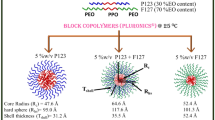Abstract
Nanotechnology is important for the development of new materials capable to improve the development of novel drug delivery systems. Such systems may result in more efficient therapeutic effects with reduced toxicity and extended time in the organism and increase in bioavailability, biocompatibility, and solubility of drugs. Here it was investigated the interaction between the triblock copolymer Pluronic F127 (F127) and a natural bioactive amphiphilic saponin (SAP), extracted from Glycyrrhiza glabra roots, aiming to form micelle-like F127-SAP complexes in a pH 7.4 HEPES buffered aqueous solution, with potential nanobiotechnological applications. Differential scanning calorimetry (DSC), dynamic light scattering (DLS), and dynamic electrophoretic light scattering (DESL) were the techniques used in this investigation, at varied SAP concentrations below and above CMC at fixed 500 μM F127. The SAP-F127 molecular interactions were verified by changes in the critical micellar temperature (CMT) of F127 obtained from the DSC thermograms, while DLS and DELS data showed, respectively, the formation larger structures of the complexes relative to the single Pluronic micelles and zeta potential (ζ) values ranging from ca − 6.5 to − 9 mV, on varying the SAP concentration. Combined, these results indicate the formation of micelle-like complexes, with structure dependent on the SAP concentration, as highly promising agents in nanobiotechnology applications.







Similar content being viewed by others
References
Sezgin Z, Yuksel N, Baykara T (2006) Preparation and characterization of polymeric micelles for solubilization of poorly soluble anticancer drugs. Eur J Pharm Biopharm 64:261–268
Branco MC, Schneider JP (2009) Self-assembling materials for therapeutic delivery. Acta Biomater 5:817–831
Polyakov NE, Leshina TV (2011) Glycyrrhizic acid as a novel drug delivery vector: synergy of drug transport and efficacy. Open Conf Proc J 2:64–72
Schwarz C, Mehnert W, Lucks JS, Muller RH (1994) Solid lipid nanoparticles (SLN) for controlled drug delivery. I. Production, characterization and sterilization. J Control Release 30:83–96
Liechty WB, Kryscio DR, Slaughter BV, Peppas NA (2010) Polymers for drug delivery systems. Annu Rev Chem Biomol Eng 1:149–173
Karsa DR (2006) What are surfactants? In: Farn RJ (ed) Chemistry and technology of surfactants. Blackwell Publishing, Oxford, pp 1–23
Zhang S (2003) Fabrication of novel biomaterials through molecular self-assembly. Nat Biotechnol 21:1171–1178
Sharma V, Agrawal RC (2013) Glycyrrhiza glabra- a plant for the future. Mintage J Pharm Med Sci 2:15–20
Raja MS, Khan I, Perumal P, Srikakolapu SR, Gotteti SD (2010) Quantitative analysis of glycyrrhizic acid in crude drug and its herbal formulation by UV spectrophotometry. Arch Appl Sci Res 2:184–189
Morgan AG, Mcadam WA (2005) Glycyrrhiza glabra. Altern Med Rev 10:230–237
Nafisi S, Bonsaii M, Manouchehri F, Abdi K (2012) Interaction of glycyrrhizin and glycyrrhetinic acid with DNA. J Photochem Photobiol B Biol 31:114–121
Nafisi S, Manouchehri F, Bonsaii M (2012) Study on the interaction of glycyrrhizin and glycyrrhetinic acid with RNA. J Photochem Photobiol B Biol 111:27–34
Saxena S (2005) Glycyrrhiza glabra: medicine over the millennium. Nat Prod Radiance 4:358–367
Hemraj RK, Singh G, Gupta A, Jalhan S, Jindal A (2013) Pharmacological activities on Glycyrrhiza glabra –a review. Asian J Pharm Clin Res 6:5–7
Graebin C, Verli H, Guimarães JA (2010) Glycyrrhizin and glycyrrhetic acid: scaffolds to promising new pharmacologically active compounds. J Braz Chem Soc 21:1595–1615
Roshan A, Verma NK, Kumar CS, Chandra V, Singh DP, Panday MK (2012) Phytochemical constituent, pharmacological activities and medicinal uses through the millenia of Glycyrrhiza glabra Linn: review. Int Res J Pharm 3:45–55
Harwansh RK, Patra KC, Pareta SK, Singh J, Rahman MA (2011) Nanoemulsions as vehicles for transdermal delivery of glycyrrhizin. Braz J Pharm Sci 47:769–778
Lorent JH, Quetin-leclercq J, Mingeot-leclercq M (2014) The amphiphilic nature of saponins and their effects on artificial and biological membranes and potential consequences for red blood and cancer cells. Org Biomol Chem 15:39–46
Sciascia L, Casalla S, Cavallaro G, Lazzara G, Milioto S, Princivalle F, Parisi F (2018) Olive mill wastewaters decontamination based on organo-nano-clay composites. Ceram Int 45:2751–2759
Zhou Q, Zhang Z, Chen T, Guo X, Zhou S (2011) Preparation and characterization of thermosensitive Pluronic F127-b-poly(-caprolactone) mixed micelles. Colloids Surf B: Biointerfaces 86:45–57
Riess G (2003) Micellization of block copolymers. Prog Polym Sci 28:1107–1170
De Lisi R, Gradzielski M, Lazzara G, Milioto S, Muratore N, Prevost S (2006) Aqueous block copolymer-surfactant mixtures and their ability in solubilizing chlorinated organic compounds. A thermodynamic and SANS study. J Phys Chem B 110:25883–25894
Batrakova EV, Kabanov AV (2008) Pluronic block copolymers: evolution of drug delivery concept from inert nanocarriers to biological response modifiers. J Control Release 130:98–106
Alexandridis P, Hatton TA (1995) Poly (ethylene oxide)-poly (propylene oxide)-poly (ethylene oxide) block copolymer surfactants in aqueous solutions and at interfaces: thermodynamics, structure, dynamics, and modeling. Colloids Surf A Physicochem Eng Asp 96:1–46
Alexandridis P, Athanassiou V, Fukuda S, Hatton TA (1994) Surface activity of poly (ethy1ene oxide)-block-poly (propy1ene oxide)-block-poly (ethy1ene oxide) copolymers. Langmuir 10:2604–2612
Bohorquez M, Koch C, Trygstad T, Pandi N (1999) A study of the temperature-dependent micellization of Pluronic F-127. J Colloid Interface Sci 216:34–40
Alexandridis P, Lin Y (2002) Temperature-dependent adsorption of Pluronic F127 block copolymers onto carbon black particles dispersed in aqueous media. J Phys Chem B 106:10834–10844
Escobar-chávez JJ, López-cervantes M, Naïk A, Kalia YN, Quintanar-guerrero D, Ganem-quintanar A (2006) Applications of termo-reversible pluronic F-127 gels in pharmaceutical formulations. J Pharm Pharm Sci 9:339–358
Dos Santos ACM, Akkari ACS, Ferreira IRS, Maaruyama CR, Pascoli M, Guilherme VA, De Paula E, Fraceto LF, De Lima R, Melo PS, De Araujo DR (2015) Poloxamer-based binary hydrogels for delivering tramadol hydrochloride: sol-gel transition studies, dissolution-release kinetics, in vitro toxicity, and pharmacological evaluation. Int J Nanomedicine 10:2391–2401
Nishiyama N, Kataoka K (2006) Current state, achievements, and future prospects of polymeric micelles as nanocarriers for drug and gene delivery. Pharmacol Ther 112:630–648
Salay LC, Prazeres EA, Marín Huachaca NS, Lemos M, Piccoli JP, Sanches PRS, Cilli EM, Santos RS, Feitosa E (2018) Molecular interactions between Pluronic F127 and the peptide tritrpticin in aqueous solution. Colloid Polym Sci 296:809–817
O’Brien R, Haq I (2004) Applications of biocalorimetry: binding, stability and enzyme kinetics. In: Ladbury JE, Doyle ML (eds) Biocalorimetry 2: applications of calorimetry in the biological sciences. Wiley, Hoboken, pp 21–26
Russell D, Hansen LD (2006) Calorimeters for biotechnology. Thermochim Acta 445:151–159
Ranjbar B, Gill P, Moghadam TT (2010) Differential scanning calorimetry techniques: applications in biology and nanoscience. J Biomol Tech 21:167–193
Feitosa E, Alves FR (2008) Thermotropic phase behavior in aqueous mixtures of dioctadecyldimethylammonium bromide and alkyltrimethylammonium bromide surfactant series studied by differential scanning calorimetry. Thermochim Acta 472:41–45
Löf D, Niemiec A, Schillén K, Loh W, Olofsson G (2007) A calorimetry and light scattering study of the formation and shape transition of mixed micelles of EO20PO68EO20 triblock copolymer (P123) and nonionic surfactant (C12EO6). J Phys Chem B 111:5911–5920
Feitosa E, Winnik F (2010) Interaction between Pluronic F127 and dioctadecylmethylammonium bromide (DODAB) vesicles studied by differencial scanning calorimetry. Langmuir 26:17852–17857
Feitosa E, Brown W, Wang K, Barreleiro PCA (2002) Interaction between poly (ethylene glycol) and C12E8 investigated by dynamic light scattering, time-resolved fluorescence quenching, and calorimetry. Macromolecules 35:201–207
Berne BJ, Pecora R (2000) Dynamic light scattering: with applications to chemistry, biology, and physics. Dover Publications, Inc., New York
Hunter RJ (2001) Foundations of colloid science2nd edn. Oxford University Press, Oxford
Gyulai G, Magyar A, Rohonczy J, Orosz J, Yamasaki M, Bösze S, Kiss É (2016) Preparation and characterization of cationic pluronic for surface modification and functionalization of polymeric drug delivery nanoparticles. Express Polym Lett 10:216–226
Hajimohammadi R, Hosseini M, Amani H, Najafpour GD (2016) Production of saponin biosurfactant from Glycyrrhiza glabra as an agent for upgrading heavy crude oil. J Surfactant Deterg 19:1251–1261
Torcello-gómez A, Maldonado-valderrama J, Jódar-reyes AB, Foster TJ (2013) Interactions between Pluronics (F127 and F68) and bile salts (NaTDC) in the aqueous phase and the Interface of oil-in-water emulsions. Langmuir 29:2520–2529
Butt AM, Amin MCIM, Katas H, Sarisuta N, Witoonsaridsilp W, Benjakul R (2012) In vitro characterization of Pluronic F127 and D-α-tocopheryl polyethylene glycol 1000 succinate mixed micelles as Nanocarriers for targeted anticancer-drug delivery. J Nanomater 2012:916573
Nita LE, Chiriac A, Bercea M, Wolf BA (2013) Synergistic behavior of poly (aspartic acid) and Pluronic F127 in aqueous solution as studied by viscometry and dynamic light scattering. Colloids Surf B: Biointerfaces 103:544–549
Rangel-Yagui CA, Pessoa Jr A, Tavares LC (2005) Micellar solubilization of drugs. J Pharm Pharm Sci 8:147–163
Honary S, Zahir F (2013) Effect of zeta potential on the properties of nano-drug delivery systems -a review (part 2). Trop J Pharm Res 12:265–273
Chandaroy P, Sen A, Alexandridis P, Hui SW (2002) Utilizing temperature-sensitive association of Pluronic F-127 with lipid bilayers to control liposome cell adhesion. Biochim Biophys Acta 1559:32–42
Funding
We thank Fundação de Amparo à Pesquisa do Estado da Bahia - FAPESB (grant number 6769/2011) for financial support. R.S.S.O. thanks FAPESB for the grant. N.F.S. thanks CAPES for the grant. N.S.M.H. and M.L. thank CAPES for the grants. E.F. thanks CNPq for the research grant.
Author information
Authors and Affiliations
Corresponding author
Ethics declarations
Conflict of interest
The authors declare that they have no conflicts of interest.
Additional information
Publisher's note
Springer Nature remains neutral with regard to jurisdictional claims in published maps and institutional affiliations.
Rights and permissions
About this article
Cite this article
de Oliveira, R.S.S., Marín Huachaca, N.S., Lemos, M. et al. Molecular interactions between Pluronic F127 and saponin in aqueous solution. Colloid Polym Sci 298, 113–122 (2020). https://doi.org/10.1007/s00396-019-04552-z
Received:
Accepted:
Published:
Issue Date:
DOI: https://doi.org/10.1007/s00396-019-04552-z




